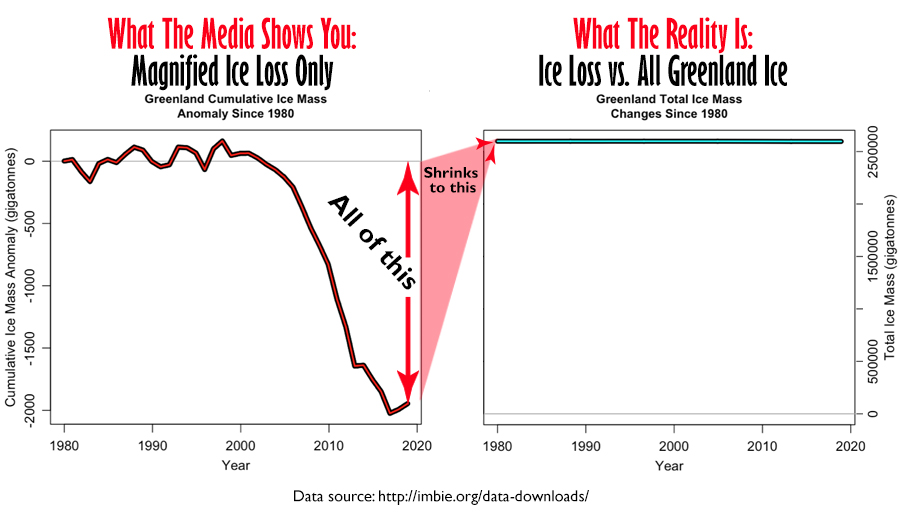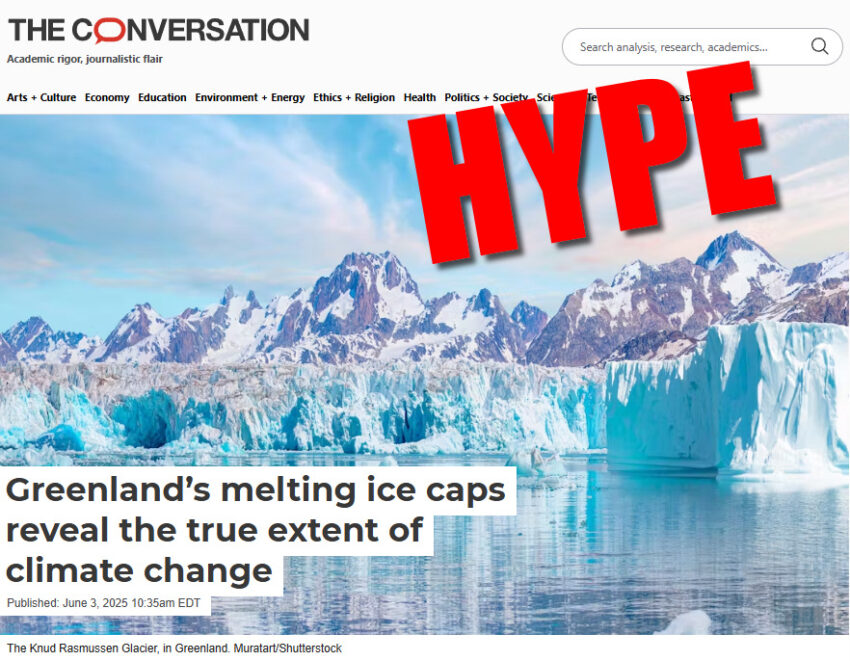A June 3, 2025 article in The Conversation, titled “Greenland’s melting ice caps reveal the true extent of climate change,” claims that retreating glaciers and melting ice are transforming Greenland’s coastline, providing proof of the severity of man-made climate change. The article states, “[t]his rapid reduction not only has consequences for Greenland’s 56,000 inhabitants, but also on a global scale, as it affects rising sea levels and the balance of the planet’s climate systems.” This claim is highly misleading. A closer look at the actual data reveals that while Greenland’s ice does melt seasonally, the net loss is vastly overstated in terms of both context and consequence. The evidence shows that the total ice volume in Greenland is so immense that these melt events barely register on the global scale.
Greenland’s ice sheet holds about 2.9 million cubic kilometers of ice. Each year, it experiences a melt season during the summer, followed by an accumulation season during the long, dark winter. This is not new. It has been happening for centuries. According to Climate at a Glance, even the much-hyped 2019 melt season, one of the highest in recent memory, amounted to just 0.1% of Greenland’s total ice mass as seen in the figure below. That amount is hardly “revealing the true extent of climate change.”

The Conversation article leans heavily on the premise that ice loss has “outpaced previous estimates by 20%”—but this is little more than statistical smoke. When the baseline estimates are revised upward due to better satellite technology or changes in modeling assumptions, we must ask: is the ice truly disappearing faster, or are we simply observing it with a more exaggerated lens?
Next, we’re told that retreating glaciers are redrawing the coastline and that a 2,500 km increase in Arctic coastline over 20 years is somehow an emergency. Historically glacier retreat and expansion are a natural part of the glacial lifecycle. Glaciers advance and retreat depending on precipitation and temperature—more snowfall means advance, less snowfall or greater melt means retreat. In Greenland, the snow accumulation zone remains robust. According to a peer-reviewed study in Nature Geoscience, snowfall over interior Greenland has actually increased in recent decades. This underscores a fundamental point: it’s precipitation, not temperature alone, that controls the size of glaciers. Snowfall feeds glaciers, and unless you’re tracking that, your melt panic doesn’t paint the complete picture.
The article also dances around the issue of sea level rise but stops short of quantifying it—likely because the numbers would undermine the alarmism. If Greenland lost ice at the 2019 rate every year (which it doesn’t), sea level would rise just 1.5 inches per decade. This amount is not outside the range of historic natural variability and would certainly not prove catastrophic. Sea level has been rising since the end of the last ice age and there’s no evidence to suggest we’re seeing anything outside of that long-term trend. In fact, research shows that Greenland has been warmer in the past and recent research shows that Greenland has been ice free in the past, even when atmospheric carbon dioxide concentrations were much lower than at present.
The authors also mention melting permafrost and coastal erosion as evidence of climate danger. Again, this cherry-picks the worst-case scenarios without noting that permafrost thawing is hyper-local and varies widely with terrain, vegetation cover, and hydrology. Even if permafrost thaws in some coastal locations, it has little to do with the Greenland ice sheet and more to do with local conditions—and yes, cyclical climate patterns that predate SUVs.
The authors also cherry-pick glacier data focusing on retreating glaciers, while ignoring that fact that many of Greenland’s glaciers are stable or even advancing. According to NASA’s GRACE satellite data and other datasets summarized at Climate Realism, short-term variations in glacier movement are influenced by bedrock geometry, oceanic oscillations, and weather—not just temperature. Claims that glacier retreat is somehow “proof” of anthropogenic climate change are unsupported by a full review of the data.
Let’s also address the fallacy of linear extrapolation present throughout the article. The authors assume that a trend observed over 20 years can be extended indefinitely into the future. This violates basic principles of climate variability. Greenland has experienced warmer periods in the past, such as the Medieval Warm Period, when Norse settlers farmed in what is now frozen tundra. The idea that today’s trends are unprecedented is simply false. Ice loss and glacier retreat have happened before—and they have reversed before.
Finally, we come to climate modeling. The authors put faith in climate models to “project future scenarios,” but research shows that climate models have consistently overestimated warming and underestimated natural variability. As documented at Watts Up With That, these models are not validated forecasting tools but speculative simulations filled with assumptions. The supposed “integration” of remote sensing with models doesn’t correct for bias—it compounds it.
In conclusion, the narrative spun by The Conversation is a classic case of selective science wrapped in climate alarmism. Greenland’s ice sheet is vast, resilient, and far from being in crisis. Summer melt is a normal seasonal event. Glaciers retreat and advance due to a complex mix of factors, primarily snowfall—not just warming. And the supposed sea level implications are trivial when compared to the dire tone of the article.
Shame on The Conversation for parroting climate panic without rigorous scrutiny. If the story’s writers had bothered to examine the full scope of glaciological science—or even take a glance at precipitation trends and long-term natural variability—they’d see that the ice caps aren’t a smoking gun for a human-caused climate catastrophe. Greenland’s glaciers are just doing what they’ve done throughout history, waxing and waning along with changing climatic, oceanic, and regional conditions, not threatening to inundate the world.
The post The Conversation’s Greenland Glacier Retreat Hype Isn’t Supported by History or Data appeared first on ClimateRealism.
Click this link for the original source of this article.
Author: Anthony Watts
This content is courtesy of, and owned and copyrighted by, https://climaterealism.com and its author. This content is made available by use of the public RSS feed offered by the host site and is used for educational purposes only. If you are the author or represent the host site and would like this content removed now and in the future, please contact USSANews.com using the email address in the Contact page found in the website menu.








